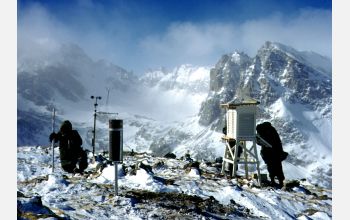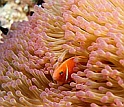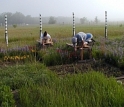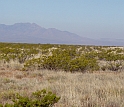News Release 06-129
Ecological Change, Climate Variation Addressed at International Conference Sept. 20-24
From desert to prairie, tropical reef to Antarctic ice, scientists to discuss long-term ecology studies

High-mountain ecosystems are studied at the Niwot Ridge, Colo., LTER site.
September 12, 2006
This material is available primarily for archival purposes. Telephone numbers or other contact information may be out of date; please see current contact information at media contacts.
Ecosystem responses to increasing urbanization in cities like Phoenix, links between declining Eastern hemlock trees and river and stream ecosystems, coral reef dependence on symbiotic crabs, and the history and future of long-term ecological research are among subjects to be addressed at the 6th Long-Term Ecological Research All-Scientists Meeting, sponsored by the National Science Foundation (NSF).
The conference will be held from Sept. 20-24, 2006, in Estes Park, Colo.
More than 700 scientists who conduct long-term ecological research (LTER) will attend. Among those speaking are James Collins, NSF assistant director for biological sciences, and David Lightfoot, NSF assistant director for social, behavioral and economic sciences.
"It's more important than ever to understand how Earth's biosphere is changing over the long term," said Collins. "NSF's LTER program is at the forefront of scientific research in developing that understanding."
NSF supports a network of 26 LTER sites located in the world's major biomes, from the coldest desert to tropical coral reefs. The network also includes sites that address the range of human influence on ecosystems, from almost none in Antarctica to significant in urban Phoenix and Baltimore. The research is funded primarily by NSF's Directorate for Biological Sciences, with additional support from the Directorate for Geosciences, Office of Polar Programs, and Directorate for Social, Behavioral and Economic Sciences.
Highlights of the meeting include:
The LTER Network: Past, Present...and Future
In a special session on the history of the LTER network, scientists involved in the effort since it began, including John Magnuson of the University of Wisconsin at Madison and Paul Risser of the University of Oklahoma, will review the LTER network's beginnings. According to Magnuson, scientists realized in the late 1970s they needed to better understand ecological dynamics over decades or even centuries, hence the formation of the LTER network in 1980. Former director of the LTER network office, James Gosz, will talk about the past decade of LTER research, in which the process of evaluation of scientific contributions from the network began, and during which such centers as the National Center for Ecological Analysis and Synthesis were formed.
NSF's James Collins will look at the future of long-term ecological research, the role of theory development, systems biology, and the integration of the natural and social sciences. Collins will raise such questions as: What changes in research and training might be expected as technology plays an increasing role in how ecological data are collected and analyzed? And, how might long-term ecological research inform issues at the intersection of biology and society?
Mangrove loss in Thailand: economics, history and long-term ecological change
Today's scale of global economic development and population growth suggests a pattern of natural resource exploitation, land conversion and habitat change unprecedented in its transformation of ecosystems, scientists have found. The result is increased "ecological scarcity"--the loss of key ecological services, which in turn has sparked interest in "valuing" these critical services.
Scientist Edward Barbier of the University of Wyoming will discuss this situation, using the example of mangrove losses in Thailand. Over the past two decades, the rise in the number and frequency of coastal natural disasters in Thailand and the simultaneous rapid decline in coastal mangrove systems is more than a coincidence, said Barbier. Widespread loss of mangroves in coastal areas of Thailand has increased the vulnerability of these areas to natural disasters.
Importance of long-term research in understanding ecological and social change
Better knowledge of how social and ecological change occur is needed to improve policies and practices for reversing the decline of global ecosystems, according to scientist Steve Carpenter of the University of Wisconsin at Madison, who will speak about long-term research as a key source of this understanding.
Carpenter will pose such questions as: What sets the stage for transitions in social-ecological systems between periods of routine, incremental change, and radical, transformative change? And what is the role of external and internal factors in evoking this change? Carpenter will suggest "expanding the scope of long-term science to include society as well as its life support systems."
Salt marshes maintain their elevation against rising sea level--to a point
Growth of salt marsh grasses increases with rising sea levels--until a critical point is reached. When marsh grass production increases, so does trapping of sediments and production of organic matter, which raises the elevation of the marsh. But elevation eventually declines as the rate of sea level rise continues to increase. Ecologist James Morris of the University of South Carolina presents results from the Plum Island, Mass., LTER site showing that marshes collapse when a critical point is reached as sea level rise accelerates.
Ecosystem response to atmospheric pollutants in and around cities: Phoenix
Urban areas occupy just 2 percent of land cover globally, but house 50 percent of the world's population. The products of intense human activity in cities include atmospheric pollutants that can affect not only plants, animals and people living in these cities, but ecosystems located downwind. To better understand the causes and consequences of atmospheric pollutants on ecological systems, researchers at the Central Arizona-Phoenix LTER site are monitoring sites upwind, downwind, and within the Phoenix metro area, the fifth largest and second fastest-growing city in the United States.
To date, results indicate that fall-out from the atmosphere of carbon- and nitrogen-based compounds is highest at locations within and downwind of Phoenix. Scientists like Nancy Grimm of Arizona State University are measuring plant growth and biological activity in soils at a series of desert sites across the Phoenix metro area. Initial results show that plant growth is significantly higher at sites within the city. The increase may be related to more nitrogen deposited from the atmosphere from human activity like fossil fuel combustion.
River-edge ecosystems affected by decline of eastern hemlock, increase in rhododendron
Riparian, or river- and stream-edge, trees help maintain biodiversity and support ecosystems in adjacent watercourses through "leaf litter" that falls into the water. Declines in Eastern hemlocks are altering riparian tree community composition in eastern U.S. forests. Scientists predict losses of the trees will result in increases in rhododendron abundance, and an overall decrease in tree species diversity.
Scientists John Kominoski and Catherine Pringle of University of Georgia tested the importance of species diversity on leaf litter processing in a southern Appalachian stream at the Coweeta LTER site. They found the presence of rhododendron inhibited microbial decomposition of the leaves. Potential effects of increased rhododendron on stream microorganisms and organic matter processing is concerning, say the researchers, as it may significantly alter these ecosystems.
Nitrogen deposition affects fungi, and tundra and forest plants along with them
Symbiotic mycorrhizal fungi have supplied nitrogen from the soil to the roots of their host plants for hundreds of millions of years. A method that estimates how much nitrogen moves through this symbiotic association is the subject of a poster by scientists John Hobbie of the Marine Biological Laboratory in Woods Hole, Mass., and Erik Hobbie of the University of New Hampshire. In return for supplying most of the nitrogen for plant growth, the fungi use 15-20 percent of the sugars produced by the host plant's photosynthesis.
Where nitrogen deposition is moderate to high, such as in the eastern U.S. or most of Europe, that process isn't happening: the fungi are absent. The unneeded sugars are then used for increased plant growth. Without the mycorrhizal fungi to "mine" soils for organic nitrogen, there may be a long-term increase in amount of organic matter found in these soils, says John Hobbie, with unknown effects.
Plant community responses to nitrogen enrichment vary
Nitrogen deposition, a result of fossil fuel combustion and agricultural runoff, is increasingly affecting natural areas. To understand how plant communities are altered, a group of researchers synthesized data from nitrogen fertilization experiments at LTER sites across North America, including desert, tundra, salt marsh and prairie ecosystems.
Ecologists Christopher Clark and Joe Fargione (Cedar Creek LTER), Steven Pennings (Georgia Coastal Ecosystems LTER), Elsa Cleland and Katharine Suding (Niwot Ridge LTER), Laura Gough (Toolik Lake Arctic LTER) and Scott Collins (Sevilleta LTER) found that nitrogen addition reduced the diversity of plant species, but that plant community responses varied among ecosystems and depended upon species traits.
Symbiotic crabs maintain coral health by clearing sediments
Coral reefs are one of the most productive and diverse ecosystems in the world.But the health of these reefs is facing threats from climate change and land use patterns that result in high rates of sediment deposit. Although many corals can remove sediment from their surfaces, increasing amounts of sediment blanket corals, causing bleaching and death.
Scientists Hannah Stewart of the University of California at Santa Barbara and her colleagues show the importance of a coral association with trapeziid crabs in reducing the effects of sediments on corals at the Moorea Coral Reef LTER site. Removing the crabs from the corals resulted in the death of 50 to 80 percent of the corals in less than 1 month; by contrast, all corals hosting crabs survived. For surviving corals without associated crabs, growth rate was slower, tissue bleaching was greater and sediment load was higher. Laboratory experiments revealed that corals with crabs not only shed more sediment, but that crabs are most effective at removing the very grain sizes most damaging to coral tissues.
Rapid decline in sea ice off the West Antarctic Peninsula
Regional climate-change effects are happening quickly in polar regions and are particularly evident on the West Antarctic Peninsula, where the winter temperature has warmed by 6 degrees Centigrade since 1950. Palmer LTER site scientists Sharon Stammerjohn (NASA Goddard Institute for Space Studies), Douglas Martinson (Lamont-Doherty Earth Institute) and Raymond Smith (University of California at Santa Barbara) report that sea ice in the Antarctic Peninsula is retreating much earlier in spring, and advancing much later in autumn, resulting in a decrease of some 85 days of winter sea ice. The declining duration and extent of sea-ice cover has caused a 75 percent decline in the population of Adèlie penguins along the West Antarctic Peninsula, according to scientist William Fraser (Polar Oceans Research Group, Sheridan, MT). Adèlie penguins, as well as several species of seals and whales, depend on sea ice in their normal life cycles.
The unseen melt: Geochemical evidence of increasing permafrost thaw in the Arctic
Despite evidence of Arctic warming and loss of sea ice, many measurements show a surprising lack of permafrost melting in soils there. These measurements of the maximum depth of summer thaw in soils are traditionally made using steel probes, which are limited in their use. Working at the Arctic LTER site near Toolik Lake in Alaska, Katy Keller and colleagues at the University of Michigan used a new geochemical approach to show that changes in the chemistry of streams can be explained only by permafrost melting and increasing permafrost thaw depth.
Melting water has cut deeper channels over time, and is now in contact with previously frozen soils with a different chemistry. Resulting changes in stream chemistry caused by permafrost melting may be more widespread than currently believed, which can be tested using this new geochemical method at other permafrost sites in arctic and boreal regions.
Rising Atlantic seas threaten coastal water birds
Ecologist Michael Erwin of the University of Virginia and others have monitored changes at salt marsh locations in Virginia (at the Virginia Coast Reserve LTER site), New Jersey and New England. Marshes located near lagoons in Virginia and New Jersey may not be keeping pace with sea-level rise, the scientists found.
If lagoon marshes are inundated due to rapid sea-level rise, salt marsh-dependent breeding water birds will be affected, including salt marsh sharp-tailed sparrows, seaside sparrows, black and clapper rails, Forster's, common, and gull-billed terns and laughing gulls. Most of these birds are on state or federal lists of species of concern because of population declines. Losses of large areas of marshlands also will reduce nursery areas for fish and invertebrates, the scientists believe, and drastically alter ecosystems in many Atlantic estuaries.
Climate links to animal populations in the Pacific Ocean abyss
The effects of climate variation on particulate organic carbon (POC) in the deep ocean are largely unknown. Abyss-dwelling animals rely on this organic material sinking from surface waters above as their primary food source. Variations in POC affect deep-sea animal populations, but time-series data capable of shedding light on the link have been very limited.
Working in the California Current Ecosystem LTER site, scientists Ken Smith and Henry Ruhl from the Monterey Bay Aquarium Research Institute have found that climate variability related to El Niño was linked to the supply of POC to the abyssal sea floor from 1989-2004. Variations in food supply were also correlated to the abundance of bottom-dwelling animals, with some animals favored when food is abundant and others when food is limited.
-NSF-
-
Coral reefs at the Moorea, Tahiti, LTER site are protected by their fellow denizens of the seas.
Credit and Larger Version -
Scientists research climate change effects on prairie plants at the Cedar Creek, Minn., LTER site.
Credit and Larger Version -
Ecosystems from deserts to rivers are found at the Sevilleta, N.M., LTER site.
Credit and Larger Version
Media Contacts
Cheryl Dybas, NSF, (703) 292-7734, email: cdybas@nsf.gov
Related Websites
Long-Term Ecological Research Network: http://www.lternet.edu
Conference Agenda: 2006 LTER All Scientists Meeting: http://www.lternet.edu/asm/2006/agenda
The U.S. National Science Foundation propels the nation forward by advancing fundamental research in all fields of science and engineering. NSF supports research and people by providing facilities, instruments and funding to support their ingenuity and sustain the U.S. as a global leader in research and innovation. With a fiscal year 2023 budget of $9.5 billion, NSF funds reach all 50 states through grants to nearly 2,000 colleges, universities and institutions. Each year, NSF receives more than 40,000 competitive proposals and makes about 11,000 new awards. Those awards include support for cooperative research with industry, Arctic and Antarctic research and operations, and U.S. participation in international scientific efforts.
Connect with us online
NSF website: nsf.gov
NSF News: nsf.gov/news
For News Media: nsf.gov/news/newsroom
Statistics: nsf.gov/statistics/
Awards database: nsf.gov/awardsearch/
Follow us on social
Twitter: twitter.com/NSF
Facebook: facebook.com/US.NSF
Instagram: instagram.com/nsfgov





